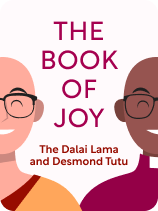

This article is an excerpt from the Shortform book guide to "The Book of Joy" by The Dalai Lama, Desmond Tutu, and Douglas Abrams. Shortform has the world's best summaries and analyses of books you should be reading.
Like this article? Sign up for a free trial here.
What is The Book of Joy by the Dalai Lama and Desmond Tutu about? What are the main takeaways of the book?
In The Book of Joy, the Dalai Lama and Archbishop Desmond Tutu offer reassurance that joy is not as elusive as you might think. While many look for joy in a different relationship, a different city, or a different job, they argue that joy can be found exactly where you are no matter what your life looks like.
Read below for an overview of The Book of Joy, Dalai Lama and Desmond Tutu’s spiritual guide to finding joy.
The Book of Joy by Dalai Lama and Desmond Tutu
The Book of Joy, written by Douglas Abrams, documents a week-long conversation between Archbishop Desmond Tutu and His Holiness the Dalai Lama about the nature of joy—what it is, why it matters, and how we can find it. The conversation, facilitated by Abrams, took place in 2015, leading up to the celebration of the Dalai Lama’s 80th birthday.
While Tutu and the Dalai Lama come from different cultural and spiritual backgrounds, they’re both known for their ability to speak to a universal human experience. Tutu, who passed away in 2021, was best known for his civil rights work during the South African Anti-Apartheid Movement, activism for which he was awarded the Nobel Peace Prize in 1984. The Dalai Lama is a Buddhist monk and the spiritual leader of the Tibetan people. He speaks internationally about the plight of Tibet and the core tenets of Buddhism. In addition to publishing his most well-known book, The Art of Happiness, the Dalai Lama has published dozens of books on Buddhist teachings, meditation, and what it means to lead a meaningful life.
In The Book of Joy, Dalai Lama and Tutu offer a window into their long friendship and a practical guide on how to live more joyfully, even in a world full of suffering.
Defining Joy
We’ll start by defining joy before discussing why the practice of joy is a worthy pursuit for ourselves and for others. According to neuroscience research, joy is one of only four basic human emotions. The other three are fear, anger, and sadness—all emotions that can cause suffering—making joy the only emotion that explores what is good and satisfying about the human experience. Joy can cover a broad range of positive experiences, including pleasure, amusement, contentment, excitement, relief, wonder, bliss, pride, and gratitude.
While many of us may conflate joy and happiness, Tutu and the Dalai Lama make a clear distinction between the two. They explain that joy, unlike happiness, is not dependent on external circumstances. Instead, joy depends on the attitude we adopt in those circumstances. Joy is a state of being, or way of looking at the world, unaffected by the ups and downs of life.
According to Tutu and the Dalai Lama, the purpose of life is to alleviate our own suffering through the discovery and practice of joy. While they agree that suffering is inevitable, they offer joy as a path through suffering. Throughout their conversation, Tutu and the Dalai Lama discuss how joy not only offers an antidote to personal suffering, but creates a virtuous cycle of well-being in which your pursuit of joy not only benefits you, but also your friends, family, and community. Their joy will inevitably increase your joy, and so the cycle continues.
The Core Values That Lead to Joy
Tutu and the Dalai Lama explain that to experience true joy, you must first understand that your joy doesn’t depend on your external circumstances. People often think that they’ll feel joy when their circumstances change—when they find a partner, have the perfect job, or finally own a house. This is the modern myth of happiness—the more you own or the more you accomplish, the happier you’ll be. In fact, the opposite is true. Focusing on external sources of happiness doesn’t lead to a more joyful life, but to great disconnection from other people and an increased attachment to things beyond your control.
Tutu and the Dalai Lama outline eight core values (called the “Eight Pillars of Joy”) that offer a pathway to a more joyful life. Practicing these eight values (perspective, humility, humor, acceptance, forgiveness, gratitude, compassion, and generosity) will help you detach your happiness from your circumstances. Douglas Abrams explains these qualities as if they are each rungs on a ladder; the practice of each quality is a natural step to the next.
The Three Truths About Suffering
Even if you know the steps you need to take to expand joy in your life, the practice often becomes more difficult when you’re in the midst of suffering. Many people believe that their own suffering or the immense suffering in the world means they can’t (or shouldn’t) feel joy.
Suffering is inevitable, but Tutu and the Dalai Lama argue that it doesn’t have to affect your overall capacity for joy. They offer three truths about suffering that can help you turn back to joy in the midst of fear, anger, envy, sadness, isolation, and even death.
The First Truth: You Can Control How You Respond to Suffering
Much of our suffering is beyond our control. You might suffer because of a natural disaster, war, or an unexpected flooded basement. These are external circumstances that you can’t change. While this type of suffering is inevitable, the Dalai Lama explains that much of human suffering is avoidable because it’s caused by our emotional response to our circumstances.
The Dalai Lama advocates for cultivating equanimity (what he calls “mental immunity”), the ability to maintain a calm and positive state of mind even in the face of adversity. Cultivating equanimity will help you minimize the internal suffering caused by negative emotions like anxiety, anger, envy, sadness, and loneliness.
Tutu and the Dalai Lama explain that fear is often the root cause of our negative emotions and therefore the cause of much of our internal suffering. In the next section, we’ll outline some strategies you can use to build up your mental resilience to negative emotions that stem from fear.
The Second Truth: Suffering Is a Universal Human Experience
According to Tutu and the Dalai Lama, the second truth to accept is that suffering is inevitable and universal. Every person experiences suffering, whether it’s the loss of a loved one or the trauma of war. In response to suffering, we often feel negative emotions like sadness or loneliness. However, recognizing the shared experience of suffering can be a balm against it because suffering is one of the things that connects us to other people.
The Third Truth: Suffering Can Lead to Insight or Opportunity
Suffering has the potential to leave you bitter or resentful, but if you choose to find meaning in your suffering, it can also give you the opportunity to grow. Tutu and the Dalai Lama argue that compassion and generosity of spirit rarely come without suffering. For example, if you’ve experienced what it’s like to be physically impaired, you’re more likely to feel compassion when someone else has a similar experience.
When suffering truly feels pointless, Tutu and the Dalai Lama counsel to remember that suffering often leads to joy. They explain that joy is not the antithesis of suffering—it’s what comes after suffering. Experiencing something hard allows you to better appreciate moments of joy. For example, when you’ve experienced a temporary physical ailment, you’re even more grateful when you regain your health and mobility.
Tutu and the Dalai Lama acknowledge that humanity’s fear and anxiety around death may be one of our greatest sources of suffering. Many of us live in fear of our own mortality. However, they explain, death is yet another part of life that’s beyond your control. It’s not only natural and inevitable, but necessary. As with other sources of suffering, you can find meaning in death. Knowing that our life spans are limited offers inspiration to live intentionally, in service of others, and, ultimately, in service of joy.

———End of Preview———
Like what you just read? Read the rest of the world's best book summary and analysis of The Dalai Lama, Desmond Tutu, and Douglas Abrams's "The Book of Joy" at Shortform.
Here's what you'll find in our full The Book of Joy summary:
- Archbishop Desmond Tutu and His Holiness the Dalai Lama's guide to joy
- What joy actually is and why it matters so much
- How to find joy exactly where you are, no matter what your life looks like






